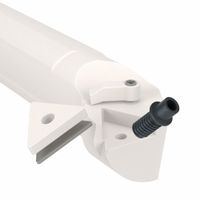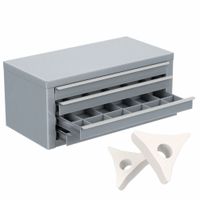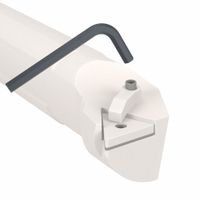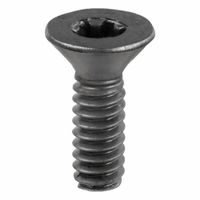Call +(254) 703 030 000 / 751 483 999 / 721 704 777
- Home
- Machining
- Indexable Cutting Tools
- Replacement Parts Accessories For Indexable Cutting Tools
.....Read More
Frequently Asked Questions
What are indexable cutting tools?
Indexable cutting tools are a type of machining tool used in manufacturing processes to cut, shape, or remove material from a workpiece. These tools feature replaceable cutting inserts that can be indexed, or rotated, to present a fresh cutting edge without the need to remove the entire tool from the machine. This design enhances efficiency and reduces downtime, as worn inserts can be quickly replaced or rotated.
The cutting inserts are typically made from hard materials such as carbide, ceramics, or cermets, which provide durability and wear resistance. These inserts are held in place by a tool holder, which is designed to securely clamp the insert and maintain precise alignment during cutting operations.
Indexable cutting tools are used in various machining processes, including turning, milling, drilling, and boring. They are favored for their versatility, cost-effectiveness, and ability to maintain consistent performance over time. The ability to replace only the cutting edge rather than the entire tool reduces material waste and lowers overall tooling costs.
These tools are available in a wide range of geometries and sizes to accommodate different machining requirements and materials. The inserts can have multiple cutting edges, allowing for several rotations before replacement is necessary, further extending the tool's life.
In summary, indexable cutting tools are essential in modern manufacturing for their efficiency, cost savings, and adaptability to various machining tasks. They enable quick insert changes, reduce downtime, and provide consistent cutting performance, making them a preferred choice in high-volume production environments.
How do I replace worn or missing fasteners on indexable cutting tools?
To replace worn or missing fasteners on indexable cutting tools, follow these steps:
1. **Identify the Fastener Type**: Determine the type and size of the fastener used in your cutting tool. Common types include screws, clamps, and wedges. Refer to the tool's manual or manufacturer specifications for details.
2. **Gather Tools and Materials**: Obtain the necessary tools such as a torque wrench, screwdrivers, or Allen keys. Purchase replacement fasteners that match the original specifications, ensuring compatibility with the tool and insert.
3. **Ensure Safety**: Wear appropriate personal protective equipment (PPE) such as gloves and safety glasses. Ensure the machine is turned off and disconnected from power to prevent accidental activation.
4. **Remove the Old Fastener**: Carefully remove the worn or damaged fastener using the appropriate tool. If the fastener is stuck, apply a penetrating lubricant to ease removal. Avoid damaging the tool body or insert seat.
5. **Inspect the Tool and Insert**: Check the tool body and insert seat for any damage or wear. Clean the area to remove debris or residue that could affect the new fastener's performance.
6. **Install the New Fastener**: Position the new fastener in place. If using screws, ensure they are tightened to the manufacturer's recommended torque settings to prevent over-tightening or under-tightening, which can lead to tool failure or insert movement.
7. **Test the Tool**: After installation, test the tool at low speed to ensure the fastener is secure and the insert is properly seated. Listen for unusual noises or vibrations that may indicate improper installation.
8. **Regular Maintenance**: Regularly inspect and maintain your cutting tools to prevent future issues with fasteners. Replace fasteners at the first sign of wear to maintain tool performance and safety.
What is the purpose of shim seats in indexable cutting tools?
Shim seats in indexable cutting tools serve several important purposes:
1. **Protection**: They protect the tool holder from damage. When a cutting insert breaks or wears out, the shim absorbs the impact, preventing damage to the more expensive tool holder.
2. **Stability**: Shims provide a stable and flat surface for the cutting insert, ensuring proper seating and alignment. This stability is crucial for maintaining precision and accuracy during machining operations.
3. **Height Adjustment**: Shims can be used to adjust the height of the cutting insert. This is important for achieving the correct cutting geometry and ensuring that the insert is positioned at the optimal height for effective cutting.
4. **Cost Efficiency**: By protecting the tool holder and allowing for easy replacement of worn or damaged inserts, shims contribute to cost efficiency. They reduce the need for frequent replacement of the entire tool holder, which is more expensive than replacing just the shim and insert.
5. **Versatility**: Shims allow for the use of different types and sizes of inserts with the same tool holder. This versatility is beneficial in machining operations that require frequent changes in cutting conditions or materials.
6. **Heat Dissipation**: Shims can aid in heat dissipation during cutting operations, helping to extend the life of both the insert and the tool holder by reducing thermal stress.
7. **Compensation for Wear**: As inserts wear down, shims can be used to compensate for the loss of material, maintaining the correct cutting position and prolonging the effective life of the insert.
Overall, shim seats enhance the performance, longevity, and cost-effectiveness of indexable cutting tools.
How do I organize and store carbide inserts?
To organize and store carbide inserts effectively, follow these steps:
1. **Categorization**: Group inserts by type, size, shape, and application. Use labels for easy identification, such as turning, milling, or drilling inserts.
2. **Storage Containers**: Use dedicated storage solutions like plastic bins, compartmentalized boxes, or specialized insert storage cabinets. Ensure they are sturdy and resistant to damage.
3. **Labeling**: Clearly label each compartment or container with the insert type, size, and any relevant specifications. Use waterproof labels to prevent smudging.
4. **Inventory Management**: Implement an inventory system to track stock levels. Use software or a simple spreadsheet to log quantities, types, and reorder points.
5. **Accessibility**: Arrange storage for easy access. Place frequently used inserts in easily reachable locations. Consider a vertical storage system to save space.
6. **Protection**: Ensure inserts are stored in a dry, clean environment to prevent corrosion or damage. Use desiccants if necessary to control humidity.
7. **Safety**: Store inserts in a manner that prevents accidental injury. Ensure sharp edges are not exposed and containers are securely closed.
8. **Regular Maintenance**: Periodically check the condition of stored inserts and storage systems. Replace damaged containers and remove any inserts that are worn out or obsolete.
9. **Documentation**: Keep a record of insert specifications, including manufacturer details and purchase dates, for reference and warranty purposes.
10. **Training**: Educate staff on proper handling and storage procedures to maintain organization and prevent damage.
By following these steps, you can maintain an organized, efficient, and safe storage system for carbide inserts.
What tools are needed to tighten and loosen fasteners on cutting tools?
To tighten and loosen fasteners on cutting tools, you typically need the following tools:
1. **Wrenches**: These are essential for gripping and turning fasteners. Common types include open-end wrenches, box-end wrenches, and adjustable wrenches. They come in various sizes to match the fasteners.
2. **Socket Sets**: These include a ratchet handle and interchangeable sockets of different sizes. They are useful for fasteners in tight spaces and provide better leverage.
3. **Allen Wrenches (Hex Keys)**: These are used for fasteners with hexagonal sockets. They come in both metric and imperial sizes.
4. **Torque Wrenches**: These are used to apply a specific torque to a fastener, ensuring it is neither too tight nor too loose, which is crucial for precision cutting tools.
5. **Screwdrivers**: These are necessary for fasteners with slotted, Phillips, Torx, or other types of heads. A set with various sizes and types is useful.
6. **Pliers**: These can be used to grip and turn fasteners, especially when they are rounded or stripped. Needle-nose pliers are useful for small or hard-to-reach fasteners.
7. **Impact Drivers**: These are power tools that provide high torque to loosen stubborn fasteners. They are especially useful for fasteners that are rusted or over-tightened.
8. **Spanners**: Similar to wrenches, spanners are used for turning nuts and bolts. They come in various types, including ring spanners and combination spanners.
9. **T-handle Wrenches**: These provide extra leverage and are often used for hex or Torx fasteners.
10. **Locking Pliers (Vise-Grips)**: These can lock onto a fastener, providing a strong grip for turning.
Having a well-organized tool kit with these tools ensures efficient maintenance and adjustment of cutting tools.
How do boring bar set pins and screws work?
Boring bar set pins and screws are essential components in the setup and operation of boring bars, which are used in machining to enlarge or finish the diameter of a hole. These components ensure the stability and precision of the boring process.
Set pins are typically used to position and secure the boring bar within the tool holder or boring head. They fit into pre-drilled holes or slots on the boring bar and the holder, aligning the bar correctly and preventing it from rotating or shifting during operation. This alignment is crucial for maintaining the accuracy of the bore and ensuring consistent results.
Set screws, on the other hand, are used to clamp the boring bar in place. They are threaded fasteners that, when tightened, exert pressure on the boring bar, holding it securely within the tool holder. The set screws are usually located on the side of the tool holder and are tightened using a hex key or similar tool. The pressure from the set screws prevents the boring bar from moving axially or radially, which is vital for maintaining the desired bore size and surface finish.
Together, set pins and screws work to ensure that the boring bar remains stable and precisely positioned during the machining process. This stability is essential for achieving high-quality bores with tight tolerances. Proper use and adjustment of these components are critical for the effective operation of boring bars, as any movement or misalignment can lead to inaccuracies, tool wear, or damage to the workpiece.
What are the benefits of using replacement parts for indexable cutting tools?
Using replacement parts for indexable cutting tools offers several benefits:
1. **Cost Efficiency**: Replacement parts, such as inserts, are more economical than replacing entire tools. This reduces overall tooling costs and allows for more frequent updates to cutting edges without significant expense.
2. **Extended Tool Life**: By replacing only the worn-out parts, the main body of the tool can be used for a longer period, maximizing the investment in the tool itself.
3. **Reduced Downtime**: Quick and easy replacement of parts minimizes machine downtime, enhancing productivity. Operators can swiftly change inserts without removing the tool from the machine, maintaining workflow continuity.
4. **Versatility**: Indexable tools with replaceable parts can be adapted for various materials and applications by simply changing the inserts, offering flexibility in manufacturing processes.
5. **Consistent Performance**: Regular replacement of cutting edges ensures consistent cutting performance and quality, as new inserts maintain sharpness and precision.
6. **Inventory Management**: Stocking inserts is more space-efficient and cost-effective than maintaining a large inventory of complete tools, simplifying inventory management.
7. **Environmental Impact**: Using replaceable parts reduces waste, as only the worn-out inserts are discarded, contributing to more sustainable manufacturing practices.
8. **Customization**: Different insert geometries and coatings can be selected to optimize performance for specific materials and cutting conditions, enhancing tool efficiency and lifespan.
9. **Improved Safety**: Regularly replacing worn parts reduces the risk of tool failure, enhancing operational safety.
10. **Ease of Use**: The design of indexable tools allows for straightforward replacement of parts, often without specialized training, making them user-friendly for operators.




